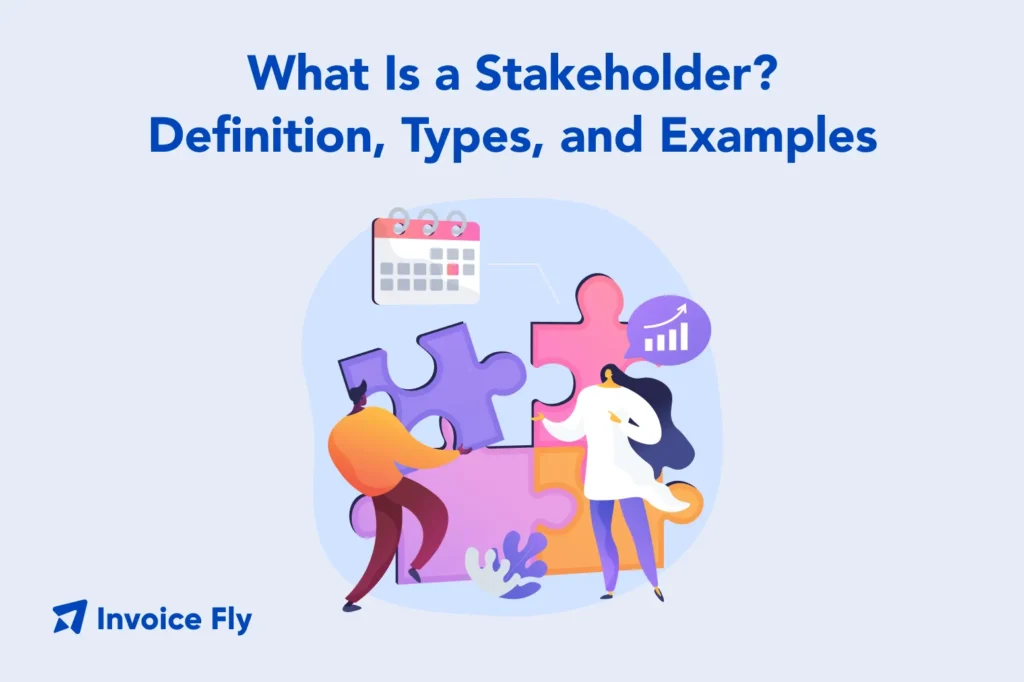What Is a Stakeholder? Definition, Types, and Examples

Table of Contents
- What Is a Stakeholder?
- Why Stakeholders Matter in Business and Projects
- Types of Stakeholders
- How to Identify and Manage Stakeholders
- Examples of Stakeholders in Different Industries
- Stakeholder Engagement Tips and Templates
- Why Understanding Stakeholders Reduces Risk
- Final Thoughts About Stakeholders
- FAQs About Stakeholders
A stakeholder is any individual or group that has an interest or influence in a company’s actions, goals, or outcomes. Stakeholders can include employees, investors, customers, suppliers, government agencies, or even local communities.
Understanding stakeholders’ meaning in business helps businesses make better decisions, build stronger relationships, and achieve long-term success.
In this guide, we’ll explain what a stakeholder is, the main types of stakeholders in business and projects, and show real-world examples of how they shape results.
What Is a Stakeholder?
According to Cornell Law School’s Legal Information Institute, a stakeholder is any person or entity that has a legitimate interest—financial or otherwise—in the activities of an organization. In simple business terms, a stakeholder is anyone who can affect a business or project, or is affected by it. That includes people inside the company or organization and people outside it. If your decisions change their work, income, safety, or community, they are a stakeholder.
Stakeholders vs. Shareholders
These terms sound similar but mean different things. Let’s take a closer look:
- A shareholder owns stock in a company and is mainly focused on financial returns.
- A stakeholder may or may not own stock. They care about the company’s results, but also about jobs, service quality, ethics, safety, the environment, and long-term impact.
How stakeholders influence outcomes
Stakeholders shape decisions through feedback, expectations, regulations, buying choices, and funding. For example, employees influence quality and speed, customers decide what sells, and regulators set legal limits that guide operations.

Why Stakeholders Matter in Business and Projects
Understanding your stakeholders gives you a competitive edge. It helps you set realistic goals, spot risks early, and choose strategies that work for everyone involved. It also helps you set up a solid business structure to determine which stakeholders have formal decision-making authority and how responsibilities are distributed.
Where stakeholders matter most
- Decision-making and strategy. Leaders rely on stakeholder input to set priorities, manage budgets, and choose trade-offs.
- Project planning and delivery. Clear communication with stakeholders prevents scope creep, missed deadlines, and rework.
- Reputation and compliance. Trust from customers, regulators, and communities reduces friction and protects the brand.
- Performance and results. Engaged employees, aligned suppliers, and loyal customers create better outcomes.
Real-world examples of stakeholders
Sarah runs a small construction company in Austin. When she started a new housing project, she met with neighbors early to address concerns about noise and traffic. By listening to these community stakeholders, she adjusted her work hours and avoided delays from complaints. She also improved her contractor cash flow management by setting clear payment expectations with all project stakeholders from the start. The project finished on time, and she even got referrals from grateful neighbors.
Marcus manages a software team. Before launching a new feature, he gathered input from users, developers, and the support team. The users wanted simpler navigation. The developers needed more time for testing. The support team wanted better documentation. By balancing these stakeholder needs, Marcus delivered a feature that worked well and didn’t overwhelm his support staff.
Quick win! Clear stakeholder communication supports better project outcomes. You can track metrics and share updates with Business Reports.
Types of Stakeholders
Stakeholders are often grouped by how close they are to your business and how directly they feel the results.
Internal stakeholders
People inside the organization with day-to-day influence.
- Employees. Deliver products and services, protect quality, and innovate.
- Managers. Set goals, allocate resources, and coordinate teams.
- Owners and founders. Provide direction and accept risk.
- Board members. Oversee strategy and hold leadership accountable.
External stakeholders
People or groups outside the organization who still have a stake in outcomes.
- Customers. Expect value, reliability, and support.
- Suppliers and partners. Depend on fair terms and steady demand.
- Investors and lenders. Expect returns and timely reporting. Many review your income statement and balance sheet regularly to assess company health.
- Government and regulators. Enforce laws and standards.
- Communities and NGOs. Focus on social responsibility, jobs, safety, and environmental impact.
- Media and industry groups. Influence public perception.

Primary vs. Secondary Stakeholders
- Primary stakeholders are directly affected by your results. This includes employees, customers, and owners. If your business stops operating, primary stakeholders feel it immediately.
- Secondary stakeholders are indirectly affected. This includes local communities, media, or advocacy groups. They may not depend on your business for their livelihood, but your decisions still impact them.
Balancing needs between internal and external groups is part of responsible growth. Ignoring either side creates problems that can get expensive fast.
How to Identify and Manage Stakeholders
Good stakeholder management follows a simple cycle: identify, analyze, plan, engage, and review.
1) Identify stakeholders
List everyone who is affected by the project or company decisions, or who can influence them.
Ask the following questions:
- Who pays?
- Who uses what?
- Who approves?
- Who supplies?
- Who regulates?
- Who may object?
2) Analyze interests and influence
For each stakeholder, note what they want, what they fear, how much impact they can have, and how much they care about outcomes.
3) Prioritize with a stakeholder map
Create a quick two-by-two chart:
| Influence | Interest | What to do |
| High | High | Manage closely. Meet regularly and involve them in key decisions. |
| High | Low | Keep satisfied. Share high-level updates and ask for input at milestones. |
| Low | High | Keep informed. Send clear updates and provide ways to ask questions. |
| Low | Low | Monitor. Share periodic summaries or dashboards. |
4) Plan engagement
Decide who communicates, how often, and in what format. Choose simple tools: email updates, short meetings, roadmaps, and dashboards. Set ground rules for feedback and decision rights.
5) Engage and review
Follow the plan, collect feedback, adjust when conditions change, and document lessons learned.
Helpful tools for stakeholder management
- A simple stakeholder registry with names, roles, interests, influence level, and preferred communication.
- A stakeholder map to guide where you spend time.
- Status dashboards that show scope, schedule, budget, and risks in one page.
- A client portal to share files and updates securely with external stakeholders.
Tip! For legal templates or documentation related to stakeholder agreements, US Legal Forms offers helpful starting points for compliance and formal contracts.

Examples of Stakeholders in Different Industries
| Industry | Key stakeholders | How they shape outcomes |
| Construction | Clients, contractors, subcontractors, inspectors, local government, neighbors | Permits and inspections drive timelines. Community feedback affects traffic plans and noise rules. |
| Healthcare | Patients, clinicians, insurers, hospital administrators, regulators | Patient safety and privacy rules guide processes. Payers influence which treatments are covered. |
| Software | Users, product managers, developers, support teams, investors, regulators | User feedback shapes features. Privacy laws shape data practices. Investors influence release pacing. |
| Education | Students, teachers, parents, school boards, government agencies | Standards and testing guide curriculum. Parent feedback influences programs and schedules. |
| Tourism | Travelers, hotels, local businesses, government, environmental groups | Seasonal demand changes staffing. Community and park rules guide sustainability. |
| Manufacturing | Workers, suppliers, distributors, regulators, local communities | Safety standards, supply chain timing, and environmental rules guide operations. |
| Retail | Customers, staff, landlords, suppliers, local authorities | Foot traffic, pricing, and returns policies shape store success and community relations. |
Across industries, success depends on aligning interests and communicating clearly. When stakeholders feel heard and informed, projects move faster and face fewer surprises.
Stakeholder Engagement Tips and Templates
Take a look at the tips below for successful stakeholder engagement.
Set clear expectations
Define goals, timelines, decision owners, and what “done” looks like. Misunderstandings shrink when expectations are written and shared.
Use simple, repeatable formats
- A one-page status report with wins, risks, next steps, and dates.
- A monthly Business Reports snapshot to show trends and progress.
- A shared issues log with owners and due dates to create accountability.
Make feedback easy
Offer short surveys, office hours, or a shared inbox. Invite specific input on the parts stakeholders know best, such as usability for customers or compliance for regulators.
Document decisions
Record what was decided, who approved it, and why. This protects the project when staff changes or memories fade. Good small business bookkeeping practices extend to documenting stakeholder decisions and commitments.
Close the loop
Tell stakeholders how their feedback changed the plan. Appreciation builds trust and encourages thoughtful input next time.

Why Understanding Stakeholders Reduces Risk
Many project failures happen because of people problems, not technical issues. Unclear expectations, confused roles, and poor communication cause delays and budget overruns. A simple stakeholder plan prevents common problems:
- Scope creep. Early alignment on goals prevents endless additions to your project.
- Budget surprises. Regular updates help leaders adjust resources before small problems become big ones. Tracking your gross profit vs net profit helps stakeholders understand true profitability.
- Regulatory setbacks. Early review with compliance teams avoids expensive late changes.
- Customer complaints. Testing with real users finds issues when they’re cheap to fix.
- Team burnout. When people feel included and informed, morale stays strong and turnover drops.
Understanding stakeholder meaning in your specific context helps you avoid these pitfalls. Whether you’re in healthcare, construction, software development, or any other field, the principles stay the same.
If you need to share updates with different groups quickly, use Business Reports to create clean, branded summaries that are easy to understand.
Final Thoughts About Stakeholders
Now that you understand the meaning of stakeholders and can identify them clearly, you’ll be better equipped to understand what matters to them and communicate consistently. This approach reduces risk and improves outcomes across your business.
Whether you’re launching a product, managing a construction project, improving a business process, or running marketing campaigns, a simple stakeholder plan keeps you focused on what matters. Start with a list of who’s affected. Create a basic map showing their influence and interest. Set a schedule for updates. Keep good notes on decisions and feedback. The payoff is smoother work, stronger relationships, and better results for everyone involved.
FAQs About Stakeholders
Employees, customers, suppliers, investors, or local communities are all examples of stakeholders.
Because their jobs, income, and workplace well-being are directly affected by how the company performs.
Other terms include “interested party” or “participant,” though “stakeholder” is the most common in business and project management.
Stakeholders provide input, support, or resources and help guide business decisions that impact them.
List everyone affected by your business or project, then map them by their level of influence and interest to prioritize communication and engagement.
